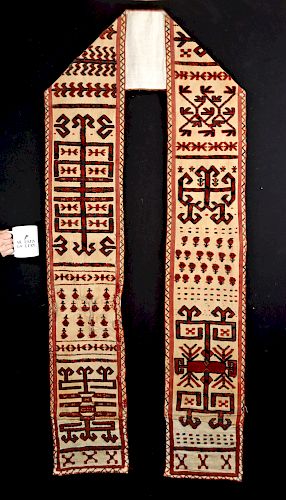Early 19th C. Saryk Tribe Textile Tent Band
Lot 102
About Seller
Artemis Fine Arts
686 S Taylor Ave, Ste 106
Louisville, CO 80027
United States
Selling antiquities, ancient and ethnographic art online since 1993, Artemis Gallery specializes in Classical Antiquities (Egyptian, Greek, Roman, Near Eastern), Asian, Pre-Columbian, African / Tribal / Oceanographic art. Our extensive inventory includes pottery, stone, metal, wood, glass and textil...Read more
Estimate:
$2,000 - $3,000
Absentee vs Live bid
Two ways to bid:
- Leave a max absentee bid and the platform will bid on your behalf up to your maximum bid during the live auction.
- Bid live during the auction and your bids will be submitted real-time to the auctioneer.
Bid Increments
| Price | Bid Increment |
|---|---|
| $0 | $25 |
| $300 | $50 |
| $1,000 | $100 |
| $2,000 | $250 |
| $5,000 | $500 |
| $10,000 | $1,000 |
| $20,000 | $2,500 |
| $50,000 | $5,000 |
| $100,000 | $10,000 |
| $200,000 | $20,000 |
About Auction
By Artemis Fine Arts
May 10, 2018
Set Reminder
2018-05-10 10:00:00
2018-05-10 10:00:00
America/New_York
Bidsquare
Bidsquare : Fine Ethnographic / Asian / Ancient Art
https://www.bidsquare.com/auctions/artemis-gallery/fine-ethnographic-asian-ancient-art-3213
Featuring antiquities from around the world including Pre-Columbian, Tribal, Classical, Asian, so much more! Artemis Fine Arts info@artemisgallery.com
Featuring antiquities from around the world including Pre-Columbian, Tribal, Classical, Asian, so much more! Artemis Fine Arts info@artemisgallery.com
- Lot Description
Central Asia, Saryk tribe, ca. early 19th century CE. A very long tent band, made of hand-knotted wool pile in russet red, navy and cornflower blue, and cream, on a woven blonde hued background. The iconography features abstract imagery inspired by flora and fauna - very stylized with an emphasis on geometry, angularity, and symmetry - as well as two panels that include rows of anthropomorphic miniature figures. The entire pattern is set within a zigzag border. Bands with a white-ground like this example are called “ak yup” by the Turkmen and were traditionally reserved for special occasions like weddings, when one would be wound around the outside of the couple's tent. Size: 129" L x 10.5" W (327.7 cm x 26.7 cm)
Woven tent bands are crucial components of trellis tents, which the nomads who have lived in the region for 1500 years use as their homes. Bands wrap around the lower part of the wooden roof struts, providing the tension necessary to brace the roof dome and support the tent as strong winds roar across the steppes. This example, however, was not necessarily relied upon for this utilitarian purpose, but was instead ceremonial and decorative. These bands were made by Turkmen women, woven in one piece on a narrow, horizontal loom placed on the ground outside the tent. A single band could take up to three years to complete. In complete form, the abstract iconography of these bands often tell a story.
Provenance: private Millburn, New Jersey, USA collection
All items legal to buy/sell under U.S. Statute covering cultural patrimony Code 2600, CHAPTER 14, and are guaranteed to be as described or your money back.
A Certificate of Authenticity will accompany all winning bids.
We ship worldwide and handle all shipping in-house for your convenience.
#132214A few sections with loose and missing fibers. Some staining and old repairs with newer yarns woven and visible seams. End panels show slightly lighter hues suggesting these panels were created later.Condition
- Shipping Info
-
All shipping is handled in-house for your convenience. Your invoice from Artemis Gallery will include shipping calculation instructions. If in doubt, please inquire BEFORE bidding for estimated shipping costs for individual items.
-
- Buyer's Premium



 EUR
EUR CAD
CAD AUD
AUD GBP
GBP MXN
MXN HKD
HKD CNY
CNY MYR
MYR SEK
SEK SGD
SGD CHF
CHF THB
THB














